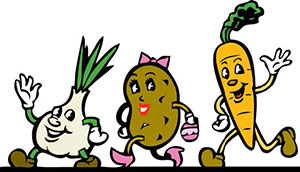Rooting for Root Vegetables
By: Megan Cooney, (Graduate Student)

As the temperatures remain cold, you might think that the season for eating local Colorado produce has passed. But don’t be fooled. Winter marks the perfect time to dig into colorful Colorado root vegetables!
While root vegetables come in all shapes, sizes, and colors, they do share a few things in common. All of these vegetables are grown underground and tend to be at their peak flavor and nutrition during the colder months of the year. This makes them an excellent ingredient to add to hearty winter dishes.
Different types of root veggies include:
- Tap Roots: Carrots, beets, turnips, radishes, rutabagas, parsnips, jicama, cassava
- Tuberous Roots: Sweet potatoes, yucca
- Tubers: Potatoes, yams, Jerusalem artichokes
- Bulbs: Garlic, onions, leeks, shallots, fennel
Digging Deeper into Root Vegetable Nutrition
Root vegetables help support the rest of the plant by absorbing water and nutrients from the soil and storing energy for the plant to use later. This makes these veggies nutritional powerhouses rich in vitamins, minerals, and antioxidants. Some benefits are:
- Parsnips are a good source of vitamin C, vitamin K, and folate. Getting enough folate during pregnancy is important because it helps to prevent some birth defects. Folate rich foods are beneficial throughout our lives, especially during rapid periods of growth, such as infancy and adolescent years.
- Beets contain antioxidant pigments that give them their red color and can reduce the risk of some cancers and diseases. Beets are also a great source of naturally occurring nitrates that support heart health. The body changes nitrates found in some plant foods into nitric oxide, which helps to improve blood flow and reduce blood pressure.
- Rutabagas are a great source of vitamin C, which helps support immune health. A medium rutabaga also has more than twice as much potassium as a medium banana.
Root veggies tend to be high in fiber and low in calories. Including root vegetables in meals can help support keeping a healthy weight and preventing chronic disease. Try choosing root vegetables of all different colors to get the full nutritional benefits!
Picking and Storing the Perfect Root
Look for veggies that are firm and unbruised. The skins of the veggies should be smooth without any large cracks or gashes. If the greens are still attached to the root, make sure they are brightly col-ored and aren’t wilted. Most root vegetables can keep for months in cool and humid conditions. Storing the vegetables in a covered container or bag in the crisper drawer of a refrigerator works well.

Dishing Up Root Veggies
Here are a few ways to enjoy root vegetables:
- Roast bite-sized pieces of root veggies to bring out their natural sweetness.
- Slice root veggies as thinly as possible and bake for a fun take on chips.
- Cook root veggies until tender and then puree with a touch of cream for a hearty soup.
Let’s Talk
Let’s face it: root vegetables can look pretty strange, and it can be hard to convince kids to give them a try. If this sounds like your child, try preparing new root veggies in familiar ways! Slice pars-nips, rutabagas, or beets into sticks and bake for a healthy take on fries. Mash up cooked sweet po-tatoes for a colorful take on mashed potatoes.
Asking your child to help pick out which root veggie they want to try when grocery shopping can also make it more likely that they will try the vegetable.
Recipes for Health
Rainbow Root Vegetable Pancakes

Ingredients:
- 1 large egg
- 1 pound assorted root vegetables (turnips, beets, parsnips, carrots, etc.), coarsely grated
- ½ pound potatoes, coarsely grated
- ½ cup finely chopped onion
- 1/3 cup flour
- ¼ teaspoon ground black pepper
- ½ teaspoon kosher salt
- ¼ cup vegetable oil
Directions:
- Beat the egg in a mixing bowl. Stir in the grated root vegetables, grated potato, chopped onion, flour, salt, and pepper.
- Heat 2 tablespoons of the oil in a large nonstick skillet over medium heat.
- Use a ½-cup measuring cup to drop mounds of the vegetable mixture into the skillet. Flatten the mounds into pancakes that are about 5 inches wide.
- Cook for about 5 minutes, until the bottoms of the pancakes are golden brown. Turn the pancakes over and cook for 4-5 minutes on the other side, until brown. Remove from the heat.
- Repeat steps 2-4 until all of the mixture has been used, adding the remaining oil to the pan as needed. You should have enough to make eight pancakes.R
Recipe adapted from The Washington Post.





